 In the Current Global scenario, India seems to reflect quite a low key IP Index. The Promotion of Innovation means rendering adequate protection to Innovators & Investors, consequentially attracting world class research and development, and creating and sustaining high-quality future jobs through a robust intellectual property (IP) structure.
In the Current Global scenario, India seems to reflect quite a low key IP Index. The Promotion of Innovation means rendering adequate protection to Innovators & Investors, consequentially attracting world class research and development, and creating and sustaining high-quality future jobs through a robust intellectual property (IP) structure.
Though in 2010, the then President of India declared the next coming 10 years to be India’s “Decade of Innovation”. But reports published by Global Intellectual Property Center since 2012 places India perpetually way behind the other emerging economies like Brazil and China and Russia due to its persisting revocation of patents to the staggering rates of piracy, placing India in the bottom for not adhering to best practices in IP rights.
India is a member of the World Trade Organization (WTO) and ever since 2005, India has been involved in improving patent protection and a host of other IP rights as an obligation to its membership. Initially, some important aspects of Agreement on Trade Related Aspects of Intellectual Property Rights (TRIPS) were implemented but it detoriated gradually. A number of policy, regulatory, and legal decisions have significantly weakened the progress made by the implementation of TRIPS, making India an outlier in the international community. For instance, In April, 2013, the Supreme Court of India, gave a major blow to the multinational pharmaceutical companies by denying grant of Patent protection sought by Novartis AG regarding a cancer drug “Glivec”.
Such decisions laid quite a negative impact on the Indian economy and a vast number of IP-based industries (including consumer goods, biopharmaceuticals, information and communication technology (ICT) etc.) and also consequentially decreased the potential tax revenue of the Indian state through piracy and counterfeiting, the large patent backlog, the recent compulsory licensing decisions, and the absence of protections to prevent unfair commercial use as the primary reasons for listing India as a Priority Watch List Country by United States Trade Representatives special 301 Report (USTR) for Notorious Markets for IP Infringement. Hence, as compared to many other emerging markets, India’s IP Structure is underdeveloped and significant flawed in both rendering adequate and effective IP protection as well as enforcement through administrative and judicial redress.
IP Rights provides protection to Innovation and investment and hence it forms to be one of the indicators of Growth and development of an Economy. The exact impact of IP rights depends on a country’s stage of development, income level, and technical capabilities.
Similarly, with regards to Innovation, economic analysis of patent rates, licensing activity, and technology transfer in countries that have strengthened their IP rights environment suggest a positive correlation between higher levels of innovation and stronger protection of IP. There are some key indicators in areas of economic activity which is directly proportional to the levels of IP protection and the figures and estimates shows how India is lagging behind the other emerging economies like China, Brazil, and Russia etc. These indicators are FDI; Receipts for the use of IP assets; Number of patents granted; Number of patents in force; and R&D expenditure.
The Overall Foreign Direct Investment Annual inflows of India have increased significantly since the early 1980s from $45million to $31 Billion currently but it still lags other countries, notably BRIC economies.
Also focusing particularly in Biomedical FDI, Countries with a more robust level of biopharmaceutical IP protection, including emerging economies, tend to enjoy a greater level of clinical trial activity by multinational research-based companies. India ranks among the lowest in attracting biomedical FDI because of its low key IP Environment.
The Research and Development (R&D) spending correlates quite strongly with rates of innovation as measured. Indian R&D spending lags significantly behind fellow BRIC economies as well as other emerging countries such as Singapore and Korea.
In 2011, payments made to Indian residents for the use of IP assets amounted to just over $300 million, which if seen in vacuum is quite good a number but in a contrast with other BRIC Economies, it is quite low in comparison (which ranged between $600 million to more than $1 billion) and other emerging markets.
Also in the Arena of Patent grant, India has enjoyed a significant increase in the number of patents granted and in force since the implementation of the TRIPS agreement in 2005. However, there has been a strong and pronounced fall since the late 2000s, a fall which coincides with the wider weakening of India’s IP environment.
To sum up, Indian economy has developed individually but has performed below that of comparable countries that have a stronger national IP environment. On rates of FDI, Biomedical FDI, receipts from IP-based assets, patenting, and R&D expenditure, India performed worse than most comparable countries. For example, with regard to annual FDI inflows, India has consistently lagged behind its BRIC peers and other middle-income countries. Similarly, in 2011, payments to Indian residents for the use of IP assets amounted to just over $300 million. This is less than half of the BRIC average or that of other emerging markets.
In conclusion, India’s failure to develop and adhere to international best practices in the field of IP rights has hindered its economic development. These Indicators clearly suggest that if India could adopt a stronger IP rights framework and policies, FDI would increase significantly, generating more revenues eventually. Increased FDI would help accelerate growth, innovation, and the building and strengthening of IP-dependent sectors of the Indian economy, and close the gap between India and comparator countries.
Source: Global Intellectual Property Center Report.
Image: flickr (st simon)
